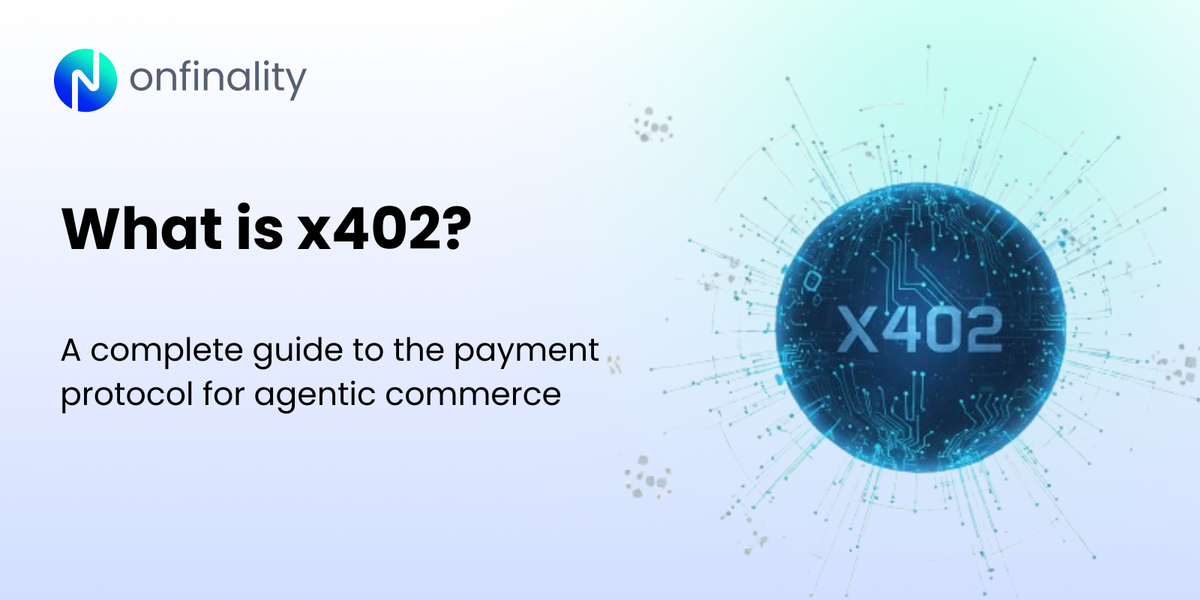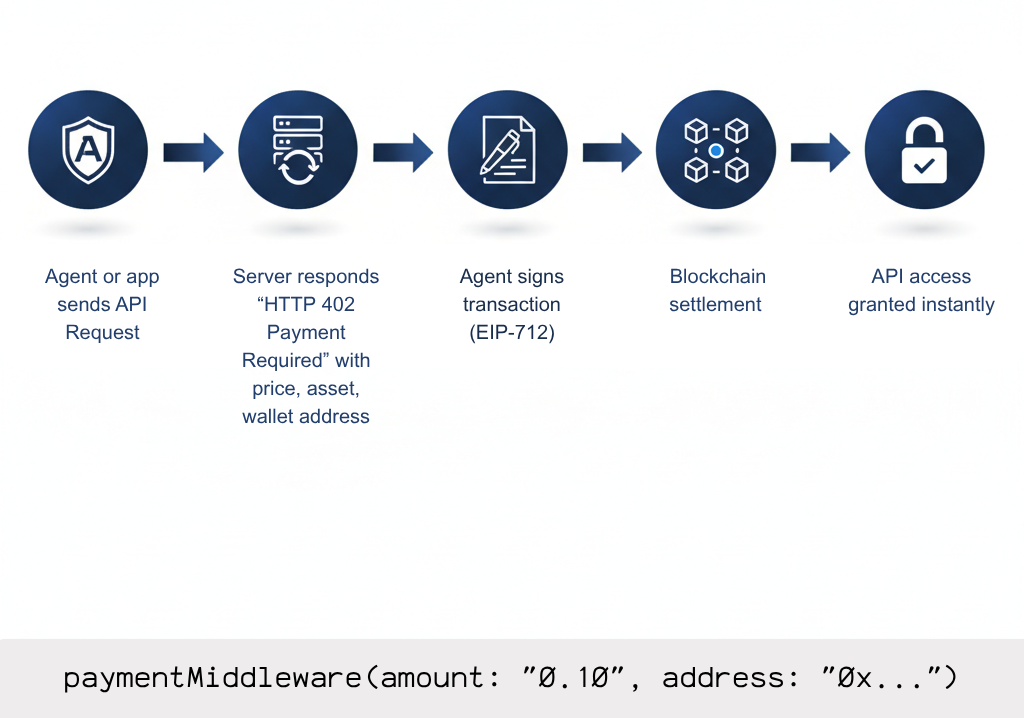What is x402? A complete guide to the payment protocol for agentic commerce
Discover how x402 is redefining onchain payments, enabling AI agents and APIs to transact autonomously in real time.

Introduction
Imagine AI agents that can buy data, pay for compute power, or unlock APIs, all without human help. That’s the world x402 is building.
Developed by Coinbase and supported by Cloudflare, x402 is an open HTTP-based payment standard that brings machine-native payments to the internet. By leveraging the long-reserved “HTTP 402: Payment Required” status code, x402 allows seamless, real-time payments between AI agents, APIs, and digital services, no API keys, subscriptions, or manual invoicing needed.
In this guide, we’ll explore what x402 is, how it works, why it matters, and how it’s paving the way for the next generation of autonomous AI-driven economies.
Table of Contents
What Is x402?
The idea behind x402 revives an almost-forgotten part of the internet’s original design, the HTTP 402 status code. When the HTTP specification was first drafted in the early 1990s, 402: Payment Required was reserved for “future use,” envisioned as a way for websites to demand a digital payment before serving content.
However, since digital money infrastructure didn’t exist at the time, the code remained unused for decades, a placeholder in every browser and server standard.
By redefining HTTP 402 for blockchain-based transactions, it enables software agents, APIs, and websites to request and verify payment natively within the web protocol itself. No extra accounts, no external payment gateways, just a clean, standardised way for machines to pay and get paid over the internet.
Why x402 Matters in 2025?
With AI models increasingly operating independently, traditional payment rails are hitting their limits. Systems like credit cards and PayPal were designed for human users, not autonomous software.
Here’s what makes x402 critical today:
- Instant settlement: Onchain payments via x402 finalize in ~200ms, compared to days for traditional banking rails.
- Global access: Available anywhere, no bank accounts or credit checks.
- Agentic commerce: Enables AI systems to autonomously pay for real-time data, cloud compute, or model inference.
- Interoperability: Works across multiple blockchains and tokens, not tied to a single ecosystem.
As Cloudflare notes, x402 could become a foundational layer for automated API monetization and AI-driven data economies, bridging Web2 infrastructure with onchain payments.

Key Benefits and Use Cases
x402 unlocks a range of new business and developer opportunities:
1. Frictionless API Monetization
- Replace subscriptions with per-request pricing.
- Enable pay-per-use billing for APIs, AI models, or datasets.
- Accept crypto payments globally without manual invoicing.
2. Autonomous AI Commerce
- AI agents can buy compute power, access data, or retrieve context in real time.
- No human-in-the-loop required for small transactions.
3. True Micropayments
- Support transactions as small as $0.001 with near-zero fees.
- Enable pay-per-article, per-second video streaming, or per-image AI inference.
4. Fraud-Resistant and Future-Proof
- Instant, irreversible payments - no chargebacks or fraud risk.
- Works with any stablecoin or blockchain network.
How x402 Works?
Here’s the simplified flow of how x402 handles payments:
- Client Request: An AI agent or app requests a paid API resource.
- 402 Response: The server responds with an HTTP 402 message specifying price, asset, and wallet address.
- Payment Authorization: The agent signs a transaction (using EIP-712 standards).
- Settlement: The transaction is verified and broadcast onchain (e.g., on Base).
- Access Granted: The API returns the requested data instantly.
This flow can be integrated in just one line of middleware code:
paymentMiddleware(amount: "0.10", address: "0x...")
Developers can test it using the @x402/express-middleware or @x402/client libraries provided by Coinbase Developer Platform.

Common Questions about x402
What makes x402 different from other crypto payment APIs?
Unlike wallet-based checkout tools, x402 integrates payments directly into the HTTP protocol, removing the need for API keys, centralized accounts, or external SDKs.
Can x402 handle microtransactions profitably?
Yes. With transaction fees below $0.0001, x402 supports extremely low-value payments that were previously impossible on traditional rails.
Is x402 limited to Coinbase or Base chain?
No. While Coinbase built the first implementation on Base, x402 is chain and token-agnostic, supporting any blockchain that uses smart contracts and stablecoins.
Final Thoughts: The Future of Machine-Native Payments
x402 represents a turning point in how AI agents and internet services interact. By standardizing payments at the HTTP protocol level, it removes the friction of subscriptions, middlemen, and manual billing, creating a foundation for autonomous digital economies.
For developers and businesses building in Web3 and AI, adopting x402 means:
- Faster monetization
- Lower operational overhead
- Access to global, programmable payments
About OnFinality
OnFinality is a blockchain infrastructure platform that saves web3 builders time and makes their lives easier. OnFinality delivers scalable API endpoints, nodes, AI Agents, and indexers for the biggest blockchain networks and empowers developers to automatically test, deploy, scale and monitor their own blockchain nodes in minutes. To date, OnFinality has served hundreds of billions of RPC requests, supports over 125 networks including Avalanche, BNB Chain, Cosmos, Polkadot, Ethereum, and Polygon, and is continuously expanding these mission-critical services so developers can build the decentralised future, faster!
App | Website | Twitter | Telegram | LinkedIn | YouTube
